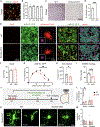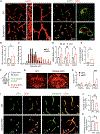Astrocytic Slc4a4 regulates blood-brain barrier integrity in healthy and stroke brains via a CCL2-CCR2 pathway and NO dysregulation
- PMID: 38709635
- PMCID: PMC11210630
- DOI: 10.1016/j.celrep.2024.114193
Astrocytic Slc4a4 regulates blood-brain barrier integrity in healthy and stroke brains via a CCL2-CCR2 pathway and NO dysregulation
Abstract
Astrocytes play vital roles in blood-brain barrier (BBB) maintenance, yet how they support BBB integrity under normal or pathological conditions remains poorly defined. Recent evidence suggests that ion homeostasis is a cellular mechanism important for BBB integrity. In the current study, we investigated the function of an astrocyte-specific pH regulator, Slc4a4, in BBB maintenance and repair. We show that astrocytic Slc4a4 is required for normal astrocyte morphological complexity and BBB function. Multi-omics analyses identified increased astrocytic secretion of CCL2 coupled with dysregulated arginine-NO metabolism after Slc4a4 deletion. Using a model of ischemic stroke, we found that loss of Slc4a4 exacerbates BBB disruption, which was rescued by pharmacological or genetic inhibition of the CCL2-CCR2 pathway in vivo. Together, our study identifies the astrocytic Slc4a4-CCL2 and endothelial CCR2 axis as a mechanism controlling BBB integrity and repair, while providing insights for a therapeutic approach against BBB-related CNS disorders.
Keywords: CCL2-CCR2; CP: Neuroscience; Slc4a4; arginine; astrocyte; blood-brain barrier; caveolin; endothelia; ischemic stroke; nitric oxide; pH regulation.
Copyright © 2024 The Author(s). Published by Elsevier Inc. All rights reserved.
Conflict of interest statement
Declaration of interests Y.K.R. is the founder of pHLIP Inc., but the company did not fund any part of the work reported here.
Figures







Update of
-
Astrocytic Slc4a4 regulates blood-brain barrier integrity in healthy and stroke brains via a NO-CCL2-CCR2 pathway.bioRxiv [Preprint]. 2023 Apr 3:2023.04.03.535167. doi: 10.1101/2023.04.03.535167. bioRxiv. 2023. Update in: Cell Rep. 2024 May 28;43(5):114193. doi: 10.1016/j.celrep.2024.114193. PMID: 37066295 Free PMC article. Updated. Preprint.
References
MeSH terms
Substances
Grants and funding
LinkOut - more resources
Full Text Sources
Medical
Molecular Biology Databases
Research Materials
Miscellaneous

